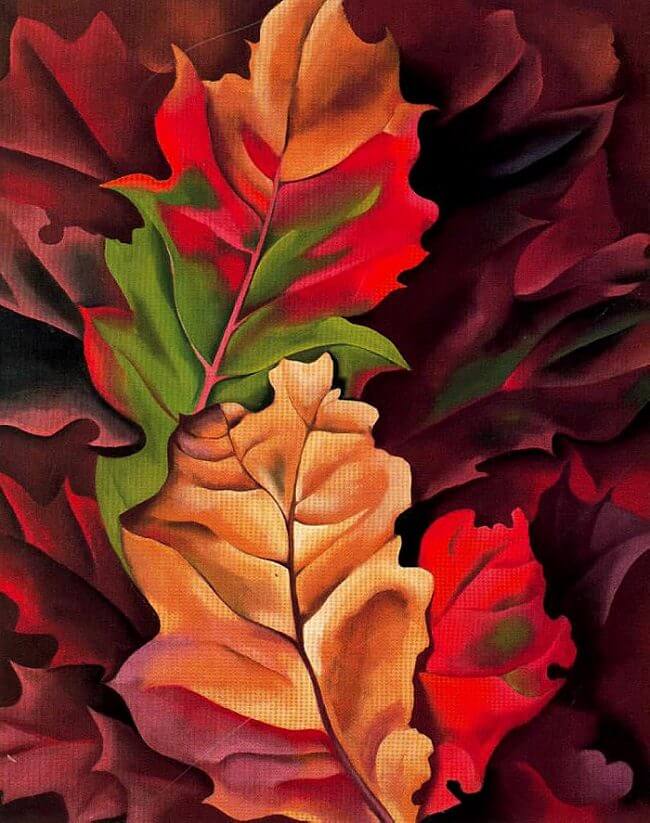Across different cultures and eras, leaves have been more than just parts of plants; they are powerful emblems of life, growth, and the ever-turning cycles of nature. From the ancient laurel leaves that crowned Greek heroes, to the fig leaves of Eden that signify human awareness, and the Bodhi tree leaves under which the Buddha found enlightenment, each leaf tells a unique tale. Let's journey through these fascinating narratives and uncover the profound meanings that these leaves hold in our collective human experience.
Amuletha™ Book of Symbols
Leaf Symbol
Autumn Leaves, Lake George by Georgia O'Keeffe, 1924
Georgia O'Keeffe, known as the "Mother of American Modernism," revolutionized art with her striking, large-scale flower paintings and vivid Southwestern landscapes. Her 1924 work, "Autumn Leaves, Lake George," exemplifies her ability to capture nature's beauty with bold shapes and colors. O'Keeffe's blend of abstraction and representation left a lasting legacy, influencing generations of artists. Her deep connection to nature and relentless creative pursuit defined her captivating life and iconic art.

Autumn Leaves, Lake George by Georgia O'Keeffe, 1924
Georgia O'Keeffe, known as the "Mother of American Modernism," revolutionized art with her striking, large-scale flower paintings and vivid Southwestern landscapes. Her 1924 work, "Autumn Leaves, Lake George," exemplifies her ability to capture nature's beauty with bold shapes and colors. O'Keeffe's blend of abstraction and representation left a lasting legacy, influencing generations of artists. Her deep connection to nature and relentless creative pursuit defined her captivating life and iconic art.
LEAF SYMBOL ORIGIN
The leaf symbol has a rich and varied history, deeply embedded in human culture and spirituality. One of the earliest known uses of the leaf as a symbol can be traced back to ancient civilizations where it represented life, growth, and renewal. In many cultures, leaves are seen as powerful emblems of nature's cycles, embodying the process of growth, decay, and regeneration.
In ancient Greece, the leaf, particularly the laurel leaf, was associated with Apollo, the god of prophecy, music, and healing. Victors of athletic competitions and poetic contests were crowned with laurel wreaths, symbolizing honor and achievement. This tradition highlighted the leaf as a symbol of victory and excellence.
In various spiritual traditions, the leaf is a symbol of enlightenment and inner growth. For instance, in Buddhism, the Bodhi leaf is revered as the tree under which Siddhartha Gautama attained enlightenment and became the Buddha. The Bodhi leaf thus represents spiritual awakening and the path to enlightenment.
The leaf symbol’s significance continues to evolve, prominently featuring in modern environmental movements. It represents sustainability, eco-friendliness, and a commitment to preserving nature. The leaf’s enduring presence underscores its deep symbolic significance, transcending cultural and temporal boundaries to symbolize life, growth, and the continuous cycle of nature.
What does leaf symbolize?
The leaf symbol holds deep significance across various cultures and eras. Here are four of the most recognized interpretations of the meanings it illustrates:
Growth
The leaf symbolizes natural growth and development, reflecting life's continual process of becoming.
Renewal
Representing renewal and regeneration, leaves signify the cycle of life, death, and rebirth, highlighting nature’s resilience.
Vitality
The vibrant green of leaves symbolizes vitality and energy, reflecting the life-sustaining power of nature.
Change
The changing colors and shedding of leaves symbolize the beauty and necessity of change, marking the transitions and progressions in life.
Cultural mention
Leaves have long been cherished symbols in cultures around the world, representing life, growth, and the cyclical nature of existence. Across various traditions, different leaves hold unique meanings, deeply embedded in the cultural and spiritual fabric of societies. From the laurel leaves of ancient Greece, signifying honor and victory, to the fig leaves in Judeo-Christian stories symbolizing modesty and the loss of innocence, and the Bodhi tree leaves in Buddhism embodying enlightenment, leaves have always told rich, symbolic stories. This exploration reveals how these leaves have transcended their botanical origins to become powerful icons in human culture.
Leaf of eternal love
The laurel leaf holds a prominent place in Greek culture, symbolizing victory, honor, and achievement. Associated with Apollo, the god of prophecy, music, and healing, the laurel leaf was used to crown victors in athletic competitions and poetic contests, signifying excellence and success. One famous legend involving the laurel leaf is the story of Apollo and Daphne. According to Greek mythology, Apollo, struck by Cupid’s arrow, fell deeply in love with the nymph Daphne. However, Daphne, struck by an arrow that made her flee from love, desperately wished to escape Apollo’s advances. In her plea for help, she was transformed into a laurel tree by her father, the river god Peneus. Heartbroken, Apollo declared the laurel tree sacred and wore a wreath of its leaves as a symbol of his eternal love and mourning. This myth not only underscores the laurel’s association with Apollo but also its enduring symbolism of triumph and poetic beauty in Greek culture.
Apollo and Daphne, Greco-Roman mosaic from Antioch

Apollo and Daphne, Greco-Roman mosaic from Antioch
Fig leaf in the story of Adam and Eve
In Judeo-Christian tradition, the leaf holds significant symbolic meaning in the story of Adam and Eve. According to the Book of Genesis, after Adam and Eve ate the forbidden fruit from the Tree of Knowledge of Good and Evil, they became aware of their nakedness and felt shame. To cover themselves, they sewed fig leaves together to make loincloths. This act of using leaves to cover their bodies symbolizes the loss of innocence and the beginning of human awareness and self-consciousness. The fig leaf has since become a powerful symbol of modesty, shame, and the human condition following the fall from grace. This story highlights the leaf’s role not only as a physical covering but also as a metaphor for human vulnerability and the complex emotions that arise from knowledge and self-awareness.
*Illustration from the Bible depicting Adam and Eve

*Illustration from the Bible depicting Adam and Eve
The legend of the Bodhi tree
In Buddhism, the Bodhi tree holds profound significance, symbolizing enlightenment and spiritual awakening. The most famous legend associated with the Bodhi tree is that of Siddhartha Gautama, who meditated under this sacred tree until he attained enlightenment and became the Buddha. According to the legend, Siddhartha, in his quest for understanding and liberation from suffering, sat beneath a large fig tree (later known as the Bodhi tree) in Bodh Gaya, India. He vowed not to rise until he had achieved profound insight. After enduring numerous trials and temptations from Mara, the demon of illusion, Siddhartha finally attained enlightenment on the full moon day of May, known as Vesak. The leaves of the Bodhi tree symbolize the path to enlightenment, each leaf representing the potential for spiritual growth and the shedding of ignorance. This sacred tree, with its heart-shaped leaves, continues to inspire millions of Buddhists around the world, serving as a reminder of the potential for spiritual awakening within each individual and the interconnectedness of all life.
*Buddha and the Bodhi Tree painting by Soma Han

*Buddha and the Bodhi Tree painting by Soma Han
Leaf symbol in the world of jewelry
Leaf symbols in jewelry are often worn by individuals who have a deep connection to nature and a passion for personal growth. These pieces appeal to a wide range of age groups, from young adults to mature individuals, each finding unique meaning in the delicate designs. Younger wearers may be drawn to the leaf symbol for its representation of new beginnings and transformation, aligning with their personal journeys of self-discovery and change. Older individuals might appreciate the leaf as a symbol of life cycles and renewal, reflecting their experiences and wisdom. The intention behind wearing leaf jewelry often revolves around themes of growth, harmony with nature, and a celebration of life’s ever-evolving journey.Giving leaf jewelry as a gift carries a message of hope, renewal, and a deep appreciation for the recipient’s personal journey. It symbolizes a wish for growth and new beginnings, making it a thoughtful gift for milestones such as graduations, birthdays, or life transitions. An interesting instance of gifting leaf jewelry might be presenting a leaf-shaped pendant to a friend embarking on a new career, symbolizing their potential for growth and success.
Leaf SYMBOL IN LITERATURE
The leaf symbol is a powerful and evocative motif in literature, often used to convey themes of growth, decay, renewal, and the cyclical nature of life. Leaves appear frequently in poetry and fiction, symbolizing the natural progression of time and the interconnectedness of all living things. Leaf symbol in literature, highlights its prominence in works that focus on nature, human experience, and philosophical reflections. Notable examples include Walt Whitman's "Leaves of Grass" and Robert Frost's poetry, which use the leaf to reflect on life's transient beauty and the constant cycle of growth and decline.
"Leaves of Grass” by Walt Whitman
One of the most famous uses of the leaf symbol is in Walt Whitman's "Leaves of Grass." In this collection, Whitman uses leaves to represent individual lives and the interconnectedness of humanity. The title itself suggests a multitude of individual experiences, each leaf a part of the greater whole. Whitman’s work celebrates the diversity of life and the unity of human experience, using the leaf as a symbol of growth, decay, and renewal within the natural world.
Illustrations for a rare 1913 Edition of Walt Whitman’s ‘Leaves of Grass’ by English Artist Margaret C. Cook

“Nothing Gold Can Stay" by Robert Frost
Nature's first green is gold,
Her hardest hue to hold.
Her early leaf's a flower;
But only so an hour
Frost uses the leaf to symbolize the fleeting nature of youth and beauty, reflecting on the inevitable passage of time and change.
“The Falling Leaf" by Ada Cambridge
We watched the last leaves fluttering down,
To lie upon the cold bare ground,
And as we gazed, we sadly mused
On all the joys we once had found.
Cambridge’s poem uses the image of falling leaves to evoke the melancholy of autumn and the transient nature of life and time. The falling leaves serve as a metaphor for the loss of past joys and the inevitability of change.
"Spring and Fall" by Gerard Manley Hopkins
Margaret, are you grieving
Over Goldengrove unleaving?
Leaves, like the things of man, you
With your fresh thoughts care for, can you?
Hopkins reflects on the sorrow of change and loss, using the leaves’ fall as a metaphor for the loss of innocence and the approach of mortality. The poem poignantly addresses the inevitability of decay and the deep emotional responses it elicits.
Thoughts
Thoughts placed alongside a symbol resonate with its meaning, serving as a guide to expand your understanding of the symbol's significance in relation to your personal experiences. AMULETHA™ also embraces this approach, invites a deeper contemplation of how symbolic meanings can reflect and enrich your life’s narrative, enhancing your appreciation of both the symbol and its broader implications.
Whispered Becoming - Softly unfolding, the leaf embodies life's endless journey of transformation, nurturing the quiet evolution within nature's embrace.
Timeless Rebirth - Gently rejuvenating, leaves weave the eternal cycle of life, death, and renewal, echoing nature’s boundless resilience and grace.
Green Pulse - Vividly alive, the leaf radiates nature’s life-sustaining energy, channeling the vibrant essence of the world's heartbeat.
Enchanted Transition - Silently evolving, the leaf’s colors shift and fall, celebrating the enchanting necessity of transition and life's continual progression.
FREQUENTLY ASKED QUESTIONS
What does a leaf symbolize spiritually?
A leaf spiritually symbolizes growth, renewal, and the cycle of life. It represents the constant process of change and the resilience found in nature's perpetual transformation.
Does a leaf symbolize good luck?
Yes, a leaf is often considered a symbol of good luck. It represents growth, renewal, and positive change, embodying the promise of new beginnings and prosperity.
What is the superstition surrounding a leaf?
One common superstition surrounding a leaf is the belief in the good luck associated with finding a four-leaf clover. Traditionally, each of the four leaves is said to symbolize something special: faith, hope, love, and luck. This rare find is thought to bring good fortune and protection against bad luck. Additionally, some cultures believe that carrying a leaf from certain trees, like an oak or bay leaf, can attract positive energy, ward off evil spirits, and bring about success and prosperity.
What does a green leaf symbolize?
A green leaf symbolizes growth, renewal, and the life-sustaining energy of nature. It represents vitality, health, and the ongoing cycle of life. Green leaves are often associated with new beginnings and fresh starts, reflecting the regenerative power of nature. They also symbolize harmony, balance, and the interconnectedness of all living things. In many cultures, a green leaf is a sign of hope and prosperity, embodying the promise of abundance and the continuous cycle of life and death.













